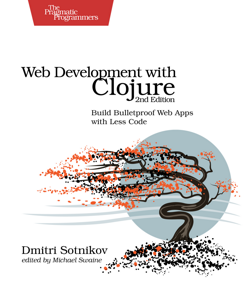Luminus uses Struct as the default validation library. Struct is a Clojure/Script library and allows us to share validation logic between the client and the server.
Struct provides struct.core/validate and struct.core/valid? functions for handling validation.
Before we see how validation works, let's include struct.core in our namespace.
(ns myapp.home
(:require
...
[struct.core :as st]))
Next, we'll define a validation schema for our data using the helpers from the struct.core namespace:
(def album-schema
[[:band st/required st/string]
[:album st/required st/string]
[:year st/required st/number]])
We can now validate the data using the schema as follows:
(st/validate {:band "MONO" :album "Hymn to the Immortal Wind" :year 2009} album-schema)
;; => [nil {:band "MONO :album "Hymn to the Immortal Wind" :year 2009}]
(st/validate {:band "MONO" :album "Hymn to the Immortal Wind" :year "2009"} album-schema)
;; => [{:year "must be a number"} {:band "MONO" :album "Hymn to the Immortal Wind" :year "2009"}]
As you can see above, the validate function will return a vector with two elements. When the data passes validation the first element will be nil, and the second will be the original data. When the validation fails, the first element will be a map of errors associated with the keys that failed validation.
The valid? function will return a boolean value indicating whether the data is valid or not:
(st/valid? {:band "MONO" :album "Hymn to the Immortal Wind" :year 2009} album-schema)
;; => true
Validation for nested data is specified using a vector path to the elements as follows:
(def schema
{[:a :b] st/integer
[:c :d] st/string})
(st/valid? {:a {:b "foo"} {:c {:d "bar"}}} schema)
;; => false
For further examples, please refer to the official project page.
 Luminus
Luminus
